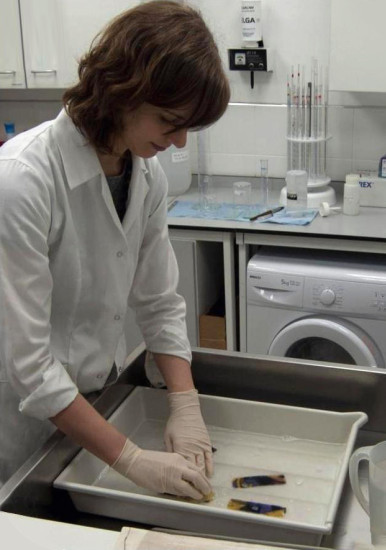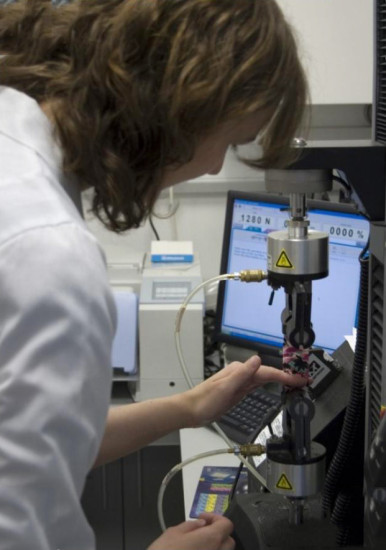By Frances Lennard, Senior Lecturer in Textile Conservation.
We are delighted that a graduate of the MPhil Textile Conservation has been shortlisted for the prestigious Pilgrim Trust Student Conservator of the Year Award, one of the categories of the 2015 Icon Conservation Awards. Charlotte Gamper’s dissertation research on the conservation of viscose rayon is one of four student projects selected by the judges for the shortlist.
Charlotte gave a presentation about her project to the judging panel on 17 July, accompanied by two tutors from the Centre—Frances Lennard and Karen Thompson. The winner of the award will be announced at an awards ceremony on 22 October 2015 at the Institution of Mechanical Engineers in London.

In her project, ‘Viscose Rayon: An Absorbing Problem’, Charlotte investigated the wet-cleaning of viscose rayon fabric and also considered challenges faced by identifying the fibre. This is a topical issue for textile conservators as this semi-synthetic fabric, first produced by Courtaulds in 1905, is the oldest man-made fibre still in production today, and is increasingly finding its way into museum collections. Viscose rayon was designed as a cheap imitation of silk but when it first appeared on the scene it was considered an exciting and desirable new material. Its wet strength however was always known to be problematic, as shown in this Lux soap advert from 1926.

Charlotte’s research successfully tackled the difficult issue of identifying a fibre which has been known by many different names over the last century, and also showed that it should be possible to wet clean viscose rayon fabrics if they are in good condition. More details have been published in the preprints of the 9th North American Textile Conservation Conference held in San Francisco in 2013.
This project was the first step in an ongoing programme of research into the conservation of modern synthetic and semi-synthetic fibres at the Centre. A short piece on MPhil graduate Stella Gardner’s dissertation research on wet-cleaning synthetic fibres was published in Icon News no. 57, pages 34-35 (2015). Our Lecturer in Conservation Science, Dr Anita Quye, has recently published a paper “Factors influencing the stability of man-made fibers: A retrospective view for historical textiles” in the journal Polymer Degradation and Stability 107, pages 210-218 (2014). doi:10.1016/j.polymdegradstab.2014.03.002
It is possible to consult Charlotte’s dissertation at the Centre for Textile Conservation at the University of Glasgow, or to obtain an electronic version (contact Frances Lennard at frances.lennard@glasgow.ac.uk).
Charlotte completed the MPhil programme in 2012 and now works in Conservation and Collection Care at Historic Royal Palaces, based at Hampton Court Palace.
We have our fingers crossed for October!



